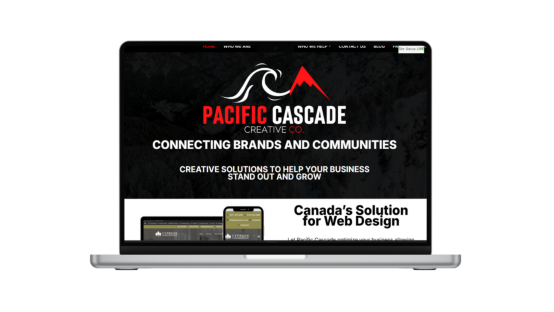
Make More. Stress Less.
Great Websites. Proven Marketing, Real Results.
Stop losing customers to companies online with better marketing. We help businesses like yours get noticed online, drive traffic, and grow revenue with simple, effective web design and marketing solutions.
You Deserve to Focus on Your Business, Not Your Website or Marketing.

You are struggling to get new customers

You want to grow your company but don’t know how

You are sick of wasting money and getting no results

You don’t have the time to work & learn marketing
Does this sound familiar? You’re not alone.
We know how frustrating it is to do great work and still get overlooked online. We know your company is more than just a job; it’s your life’s work. We build websites and strategies that get you seen, trusted and hired so you can stand out online and grow your business.
Great businesses deserve to stand out and succeed. We help make that happen.
With over 15 years of experience helping businesses like yours, our plans and strategies are tailored to grow your revenue without breaking the bank. You’ve got the skill, you’ve got the service, all you need is the write online strategy to back it up.
How We Can Help Your Business
You focus on your business, we will make sure people see it
We aren’t just website designers and marketers, we are problem solvers. We have worked with hundreds of businesses like yours who’ve felt stuck. They didn’t need motivation or an overhaul, they needed direction. That’s where we come in.
We help company owners like you reach more customers, make more money, and finally feel confident in your marketing with a great website and strategy built to stand out at any level.

Website Design
Most websites just sit there. Ours sell. Custom built to bring you more leads, more sales and more growth.
Get Your Website Here

Graphic Design
Look like a brand people trust, not a side hustle. Graphics that make your brand look sharp and stand out.
Get A Business Logo

Social Media Marketing
Stop posting into the void. Start getting real business from social media.
Boost Your Brand

Search Engine Optimization
If you’re not showing up on Google, you’re handing customers to your competitors.
Start Climbing The Ranks

Pay Per Click Ads
Buy your way to the top of the internet and only pay when someone clicks on your ads.
Reach New Customers Now

Digital Marketing
Marketing isn’t magic. It’s math. We make the numbers work in your favor.
Grow Your Company
Let’s Discuss How We Can Help You
We care about your outcomes not just your invoice. If we cant help you reach more customers and make more money, we won’t waste your time.
Our Simple, Proven Process
You’re running a great business but aren’t bringing in the money or customers like you should. Your competitors dont do better work, they just look better online. We are here to fix that.
Imagine a strategy that brings in new customers and grows your company while you eat, sleep and work. You wake up to new customers, appointments and sales. You’re finally getting the recognition you deserve.

Free Consultation
We start with a free consultation to understand your goals and challenges.

Get A Custom Plan
We create a custom plan based on your goals, ensuring the best results.

Execute The Plan
We build and launch your website or campaign, optimizing it for success.

Watch Your Business Grow
We monitor results and refine strategies to ensure ongoing growth.
Brands We’ve Helped Achieve Real Results
Real Results. Real Growth.
For over 15 years, we’ve combined creativity and expertise to help North American brands in industries like healthcare, legal services, retail, construction, oil and gas, and finance stand out in competitive markets.


Our Company
We are passionate designers and marketers dedicated to helping small businesses grow and succeed online. With over 15 years of experience, we’ve helped companies across North America reach their goal.

Our Mission
We believe small businesses are the backbone of society. We’re here to give you the tools to compete against big corporations and succeed with great websites and smart marketing that help you get more customers and make more money.
Ready To Grow Your Business?
Get A Free Consultation
Get your business online, grow your revenue, and stand out from the competition. Book Your free consultation today.
Phone: 250-401-8579
Email: Hello@pacificcascadecreative.com
Resources
Frequently Asked Questions
We value transparency and believe in keeping things clear and straightforward for our clients. If you’re not quite ready to reach out but have questions, feel free to browse here for answers. We’re always here to help.
Why work with Pacific Cascade Creative?
We’ve spent 15+ years helping businesses in competitive industries like real estate, law, healthcare, and tourism get results with websites and marketing that actually work. We focus on your goals, your audience, and what makes your business unique, then build everything else around that.
You bring the ambition. We bring the tools, strategy, and support to help you succeed.
Key Reasons Businesses Like Yours Choose Us
- Leading Canadian Agency: Recognized as one of Canada’s top web design and marketing teams.
- 15+ Years of Experience: Proven expertise in marketing across North America’s toughest and most competitive industries, including real estate, healthcare, legal services and mining.
- Customer Success Focused: We prioritize client success, delivering results-driven solutions tailored to unique business goals.
- North American-Based: A local team that understands the challenges and opportunities for businesses in Canada and the U.S.
- Industry-Specific Knowledge: Deep understanding of industries that power North America, helping businesses stand out and compete effectively.
- Strategic and Creative Solutions: Customized, high-quality web design and marketing strategies that elevate your brand and drive growth.
What makes Pacific Cascade Creative different from other companies?
What sets us apart is that we’re not just designers or marketers . We’re your guide to success.
At Pacific Cascade Creative, we remove the headaches, save you time, and bring in more business. As a full-service, all-in-one agency, you won’t need to search for a web designer, marketer, ad specialist, or graphic designer. We handle it all. We don’t outsource, so you’ll work directly with a dedicated professional, ensuring consistency and personalized service.
We know that small businesses are the backbone of society and we’re passionate about helping them compete with the big guys and get the recognition they deserve. With over a decade of experience, professional training in business management , design and marketing, we bring unique insights to drive results and guarantee we won’t stop until your business succeeds.
Are you a foreign company? Where are you located?
No, We are not foreign. We are a Canadian-owned business, founded and operated in beautiful British Columbia. However, we work with clients across Canada and the United States. We are equipped to serve your company through virtual meetings and online collaboration tools. We’re passionate about helping people establish strong digital profiles
What services do you offer?
We are proud to offer a comprehensive range of tools to help businesses establish a strong online presence. Our core offerings include website design, graphic design, branding, social media marketing, search engine optimization (SEO), and digital advertising. We focus on creating exclusive solutions for each client to ensure their brand stands out and effectively engages their target audience.
What will my project cost?
We keep pricing simple and transparent.
Every project is different, but you shouldn’t have to guess what things will cost. That’s why we created a clear pricing guide you can check out anytime. No hidden fees, just straightforward, affordable services that fit your goals. Browse our prices here.
How can I get an estimate for my project?
Whether you’re looking for professional web design or marketing solutions anywhere in Canada, we would be happy to provide a quote for your project. You can easily reach out to our team by contacting us here for a free consultation.
While we love engaging on social media, inquiries through these channels often get lost or flagged as spam. To ensure your request reaches us, please use our online form or connect with us directly.
What steps do we need to take to get to work?
Our project process is designed to ensure a seamless and collaborative experience that delivers exceptional results. Here’s a step-by-step overview of how we work with our clients:
- Free Consultation
We start by understanding your business, goals, and target audience. Through detailed consultations, we identify your needs and gather the information necessary to craft a strategic plan for your project. - Get A Custom Plan
Once we’ve defined the project’s scope, we provide a clear proposal outlining deliverables, timelines, and costs. From there, we create a detailed project plan to ensure alignment and set expectations. - Design & Execute The Plan
We build your site or strategy using modern technologies, ensuring it’s fast, responsive, and optimized for performance. After rigorous testing and approval, we launch your project and provide ongoing support to ensure its success. - Watch Your Business Grow
Now it is time to grow! We’re here to provide insights and assist with updates, maintenance, and additional enhancements as needed.
Our process emphasizes collaboration, transparency, and quality to deliver solutions that exceed expectations and drive results.
How long does it take?
The timeline depends on the complexity of your project.
For a website, the process typically takes anywhere from 1 to 8 weeks, depending on the size and features required. Marketing campaigns can start generating results within a few weeks, but the most effective strategies take time to fine-tune and optimize. We’ll provide a clear timeline up front and keep you updated throughout the process to ensure everything stays on track.
What industries or types of clients do you work with?
We work with businesses that work hard.
From law firms and real estate agents to mechanics, roofers, welders, and wellness pros—if you’re building something real, we’re here for it.
We’ve helped small and mid-sized businesses across Canada and the U.S. in industries like healthcare, construction, tourism, trades, tech, and retail. Whether you’re running a tire shop, a campground, a local government office, or a growing eCommerce brand, we know how to get you noticed online—and how to turn clicks into customers.
If you’re serious about growth, we’re ready to help you make it happen.
What website platforms do you work with?
We build websites that fit your needs—not the other way around.
Most of our sites are built on WordPress because it’s powerful, flexible, and easy to manage. But we’re not locked in. From basic builders like Wix and Squarespace to fully custom-coded sites, we’ve worked with almost every platform. Whatever your goals, we’ll build the right solution for you.
What eCommerce development platforms does Pacific Cascade Creative work with?
You want to sell online. We help you do it the right way.
Whether you’re just starting or ready to scale, we build online stores that are easy to manage and built to grow. Most of our clients use WooCommerce, but we work with platforms like Shopify and SureCart, too. We’ll help you choose what fits your business best, then build a store that looks great, works fast, and helps you make more sales.
Can you fix my existing website?
Not happy with your website? We’ll fix it.
If your site looks outdated, loads slow, or just isn’t doing its job—we can help. From small fixes to full makeovers, we’ll make your website faster, better looking, and easier for customers to use. We’ll make sure it works on all devices, ranks better on Google, and supports your business goals.
Do you offer search engine optimization services?
Yes, we offer SEO services to help businesses get noticed.
Our SEO strategies ensure your business ranks higher on Google, making it easier for customers to find you and choose you over the competition. Along with web development and digital ads, we give you the tools to grow and stand out online.
Can you help my business rank higher on Google?
Yes, we can help you rank higher on Google.
Through expert SEO strategies, we optimize your website so it appears at the top of search results. By improving content, keywords, and site structure, we make it easier for potential customers to find you—driving more traffic and helping your business grow.
Do you offer any digital marketing agency services?
Yes, we offer a full range of digital marketing services.
From targeted digital ads to social media marketing and email campaigns, we help businesses connect with their ideal customers online. Our strategies are designed to drive traffic, increase engagement, and boost sales—ensuring your business stands out in a competitive market.
Can you help with branding and logo design?
Yes, we offer logo design services.
We create custom logos that reflect your brand’s identity and make a strong impression. Our designs are unique, memorable, and tailored to your business, helping you stand out and connect with your audience.
Do you offer any guarantees on your services?
Yes, we guarantee your satisfaction with our services.
Our goal is to ensure that you’re happy with the results we deliver. If you’re not fully satisfied with our work, we’ll collaborate with you to make adjustments and ensure it aligns with your vision. We take pride in delivering high-quality solutions that help your business grow, and we’re here to guide you every step of the way. While we can’t guarantee specific results (such as a #1 Google ranking), we stand behind our work’s quality and effectiveness.





